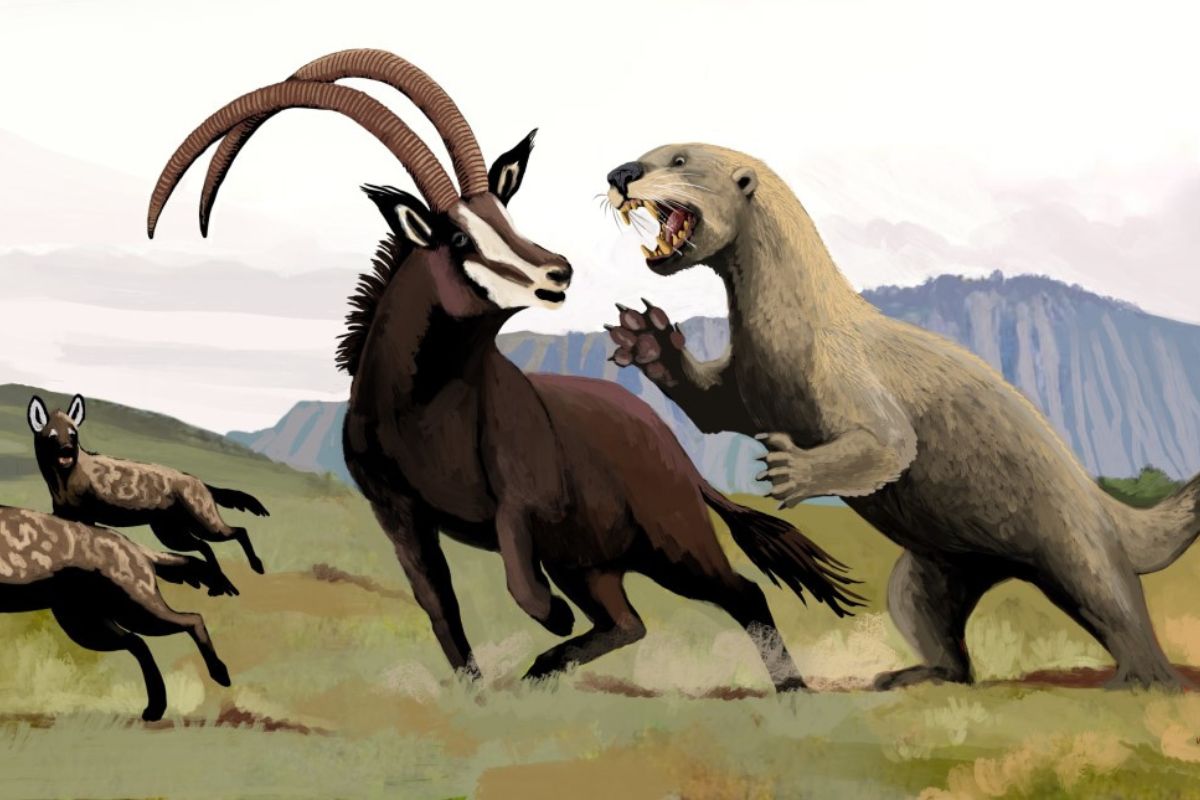
Enhydriodon omoensis, a prehistoric otter, roamed the ancient landscapes of Africa millions of years ago. This fascinating creature, much larger than today's otters, has intrigued scientists and enthusiasts alike. Imagine an otter the size of a wolf, with powerful jaws and a robust body built for both land and water. Fossils of Enhydriodon omoensis have provided a glimpse into its life, revealing details about its diet, habitat, and behavior. These ancient otters were apex predators in their ecosystems, hunting fish, mollusks, and possibly even small mammals. Join us as we dive into 40 captivating facts about this remarkable species, shedding light on its unique characteristics and the world it once inhabited.
Key Takeaways:
- Enhydriodon omoensis, the ancient giant otter, was a top predator in its ecosystem, with a powerful build and specialized adaptations for aquatic life. Its fossils provide valuable insights into the evolution of otters and prehistoric ecosystems.
- The discovery of Enhydriodon omoensis highlights the importance of fossil preservation and research, while also offering valuable lessons for modern conservation efforts. Studying extinct species can help us understand environmental changes and protect current biodiversity.
Enhydriodon Omoensis: An Ancient Giant Otter
Enhydriodon omoensis is a fascinating prehistoric creature. This giant otter lived millions of years ago and has intrigued scientists since its discovery. Let's dive into some amazing facts about this ancient mammal.
Discovery and Classification
The journey of understanding Enhydriodon omoensis began with its discovery. Here are some key points about its classification and initial findings.
- Enhydriodon omoensis was first discovered in the Omo Valley in Ethiopia.
- The species was identified from fossil remains found in the region.
- It belongs to the genus Enhydriodon, which includes several extinct otter species.
- The fossils date back to the Pliocene epoch, approximately 3 to 5 million years ago.
- Enhydriodon omoensis is one of the largest otters ever discovered.
Physical Characteristics
Understanding the physical traits of Enhydriodon omoensis helps paint a picture of this giant otter's appearance and lifestyle.
- This otter species could grow up to 2.5 meters in length.
- It had a robust and muscular build, indicating a powerful swimmer.
- The skull structure suggests strong jaw muscles, ideal for crushing hard-shelled prey.
- Its teeth were large and adapted for a carnivorous diet.
- The limb bones were sturdy, supporting its large body in aquatic environments.
Habitat and Lifestyle
Exploring the habitat and lifestyle of Enhydriodon omoensis provides insight into how it lived and interacted with its environment.
- Enhydriodon omoensis likely inhabited riverine and lacustrine environments.
- Its large size suggests it was a top predator in its ecosystem.
- The diet probably included fish, mollusks, and other aquatic animals.
- Fossil evidence indicates it coexisted with other large mammals like hippos and crocodiles.
- The otter's swimming abilities were crucial for hunting and escaping predators.
Evolutionary Significance
The evolutionary significance of Enhydriodon omoensis sheds light on the development of otters and their adaptations over time.
- Enhydriodon omoensis provides insight into the evolution of modern otters.
- Its size and adaptations highlight the diversity within the otter family.
- Studying this species helps understand the ecological roles of prehistoric otters.
- The fossil record of Enhydriodon omoensis contributes to knowledge about Pliocene fauna.
- Comparisons with modern otters reveal evolutionary changes in size and diet.
Fossil Discoveries and Research
Ongoing research and fossil discoveries continue to unravel the mysteries of Enhydriodon omoensis.
- New fossil finds help refine the understanding of its physical characteristics.
- Advanced imaging techniques provide detailed views of its skeletal structure.
- Paleontologists study wear patterns on teeth to infer dietary habits.
- Isotopic analysis of bones offers clues about its habitat and migration patterns.
- Collaborative research efforts enhance knowledge about this ancient species.
Cultural and Scientific Impact
The discovery of Enhydriodon omoensis has had a significant impact on both scientific communities and popular culture.
- This giant otter has captured the imagination of paleontology enthusiasts.
- It features in documentaries and educational programs about prehistoric life.
- Scientific papers on Enhydriodon omoensis contribute to the broader field of paleontology.
- Museums display its fossils, attracting visitors and raising awareness.
- The species highlights the importance of fossil preservation and research.
Conservation Lessons
Though Enhydriodon omoensis is long extinct, its story offers valuable lessons for modern conservation efforts.
- Studying extinct species helps understand the impacts of environmental changes.
- It emphasizes the importance of protecting aquatic habitats.
- The giant otter's extinction raises awareness about the vulnerability of large predators.
- Conservationists can learn from past ecosystems to protect current biodiversity.
- Public interest in prehistoric animals can drive support for conservation initiatives.
Fun Facts
Here are some fun and lesser-known facts about Enhydriodon omoensis that add to its intrigue.
- Enhydriodon omoensis is sometimes referred to as the "giant river otter."
- Its name, Enhydriodon, means "water tooth" in Greek.
- The species name, omoensis, refers to the Omo Valley where it was found.
- Despite its size, it shared many behavioral traits with modern otters.
- Enhydriodon omoensis is a reminder of the incredible diversity of life on Earth.
Final Thoughts on Enhydriodon Omoensis
Enhydriodon Omoensis, an ancient otter species, offers a fascinating glimpse into prehistoric life. These creatures, much larger than today's otters, roamed Africa millions of years ago. Their robust jaws and teeth suggest a diet of hard-shelled prey, showcasing their adaptability. Fossil discoveries, primarily in Ethiopia's Omo Valley, have provided valuable insights into their existence and environment.
Understanding Enhydriodon Omoensis helps scientists piece together the evolutionary puzzle of otters and their relatives. It also highlights the rich biodiversity of ancient ecosystems. As research continues, new findings may further illuminate the life and times of this remarkable species.
So, next time you see an otter, remember its mighty ancestor, Enhydriodon Omoensis. This ancient giant reminds us of the ever-changing nature of life on Earth and the importance of studying our planet's history.
Frequently Asked Questions
Was this page helpful?
Our commitment to delivering trustworthy and engaging content is at the heart of what we do. Each fact on our site is contributed by real users like you, bringing a wealth of diverse insights and information. To ensure the highest standards of accuracy and reliability, our dedicated editors meticulously review each submission. This process guarantees that the facts we share are not only fascinating but also credible. Trust in our commitment to quality and authenticity as you explore and learn with us.


